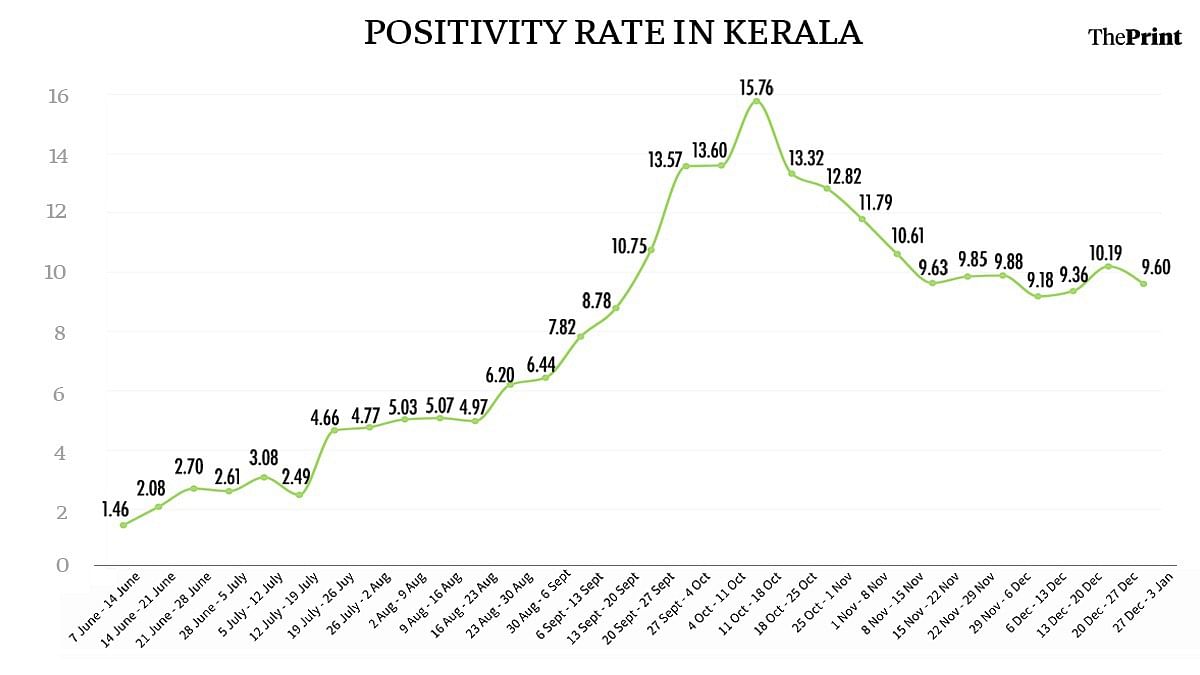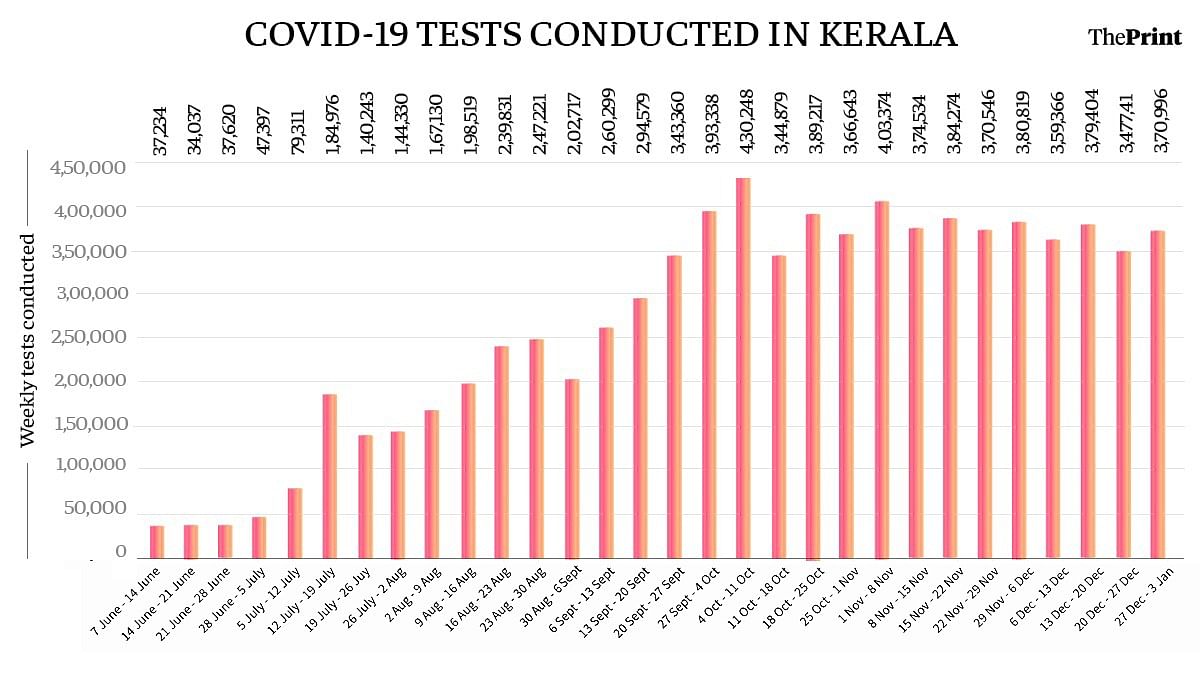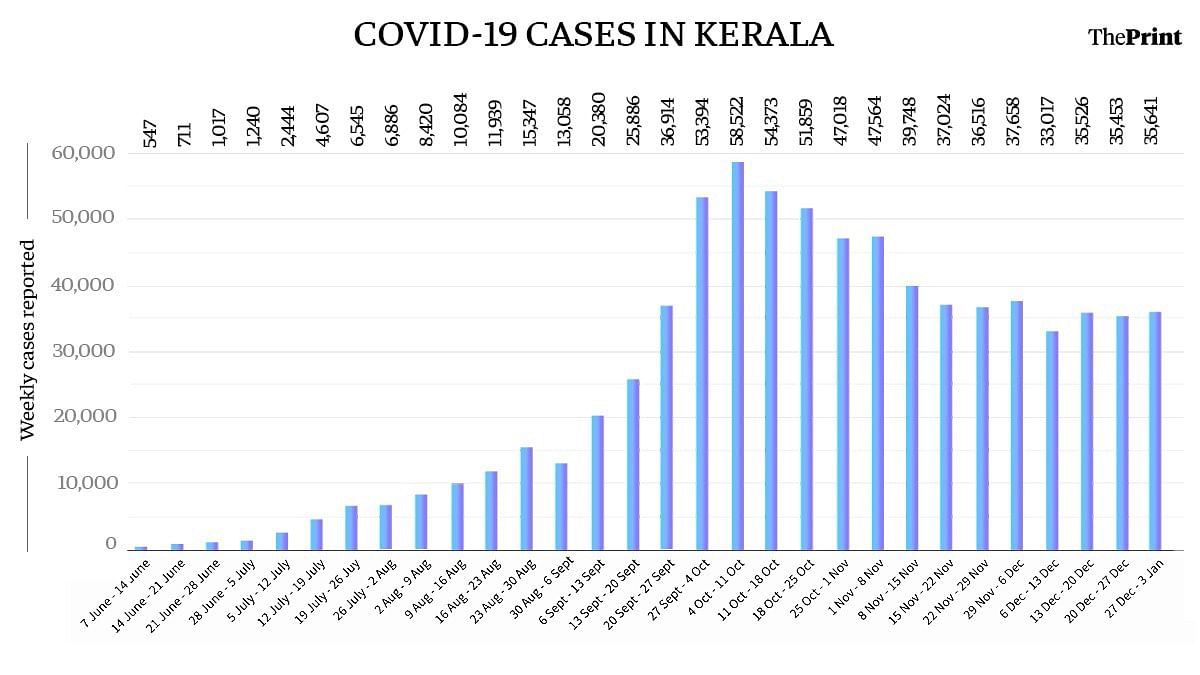New Delhi: Two months after it witnessed a dramatic first peak, Kerala is once again seeing a surge in the number of Covid-19 cases. This at a time when the country has recorded the lowest daily rise in cases in over six months.
Between 27 December and 3 January, the state’s positivity rate was recorded at 9.6 per cent (ThePrint calculated based on data from daily bulletins) while the national average for the same period was 5.8 per cent. The positivity rate or the proportion of people who test positive among all the tests conducted serves as an indication of how well a state is able to contain the infection.
Members of the state’s Covid-19 task force and experts indicated to ThePrint that the local body elections in December and the festival season could have led to a “second surge”.
Dr Amar S. Fettle, the state nodal officer for Covid-19, said the government had anticipated the surge. “We had predicted the second peak in the post-election season, but that did not happen as much, then we had predicted during Christmas and New Year,” he said, adding that it would still be early to say how the festival season has affected the Covid situation.
The Centre in a statement Wednesday said it has deployed a high-level team headed by Dr S.K. Singh, director, National Centre for Disease Control (NCDC), to the state. The same team will also be reviewing the avian flu outbreak in Kerala.

Tracking Kerala’s numbers
ThePrint analysed Kerala’s testing numbers and the positive cases since June when the state’s positivity rate was 1.46 per cent.
The state witnessed its first peak in mid-October when the positivity rate had increased to over 15 per cent. In about a month, this fell drastically by over five percentage points. The active caseload during this time also decreased to about 57,000. Testing was also drastically increased, with over four lakh tests a week being conducted in the period between 4 October and 11 October, the highest in the state.
“But again, in the previous two weeks, we have witnessed another peak. Now the active case number is around 63,000, which means we gained maybe around 15,000 cases in the active case pool. So it is considered as a second surge,” said Dr Anish T.S, associate professor, community medicine, Thiruvananthapuram Medical College Hospital. The doctor is also a public health consultant with the state’s disaster management authority.
He pointed out that since then, the curve has plateaued, which is also indicated by the positivity rate remaining between 9 and 10 per cent.

Testing figures are now at around 3.7 lakh a week, but the state has been prioritising antigen tests over the RT-PCR, considered the gold standard Covid-19 test. According to the 5 January bulletin, of the total 81,60,890 tests conducted so far, 53,72,884 or 65 per cent are antigen tests.
In contrast, the neighbouring state of Tamil Nadu has chosen to only rely on RT-PCR tests and has so far conducted over 1.45 crore such tests.
‘High susceptibility’
Dr Mohammed Asheel, executive director of the Social Security Mission and member of the health minister’s core Covid team, reasoned that the second surge pointed to the fact that the state still has a large number of “susceptible people”.
“We have a lot of people with heart disease, hypertension, diabetes … we have a higher proportion of elderly population than the national average,” he said. “We were considered as a state with the highest vulnerability that would lead to a large number of mortalities initially, but our strategy has been to delay the peak of the epidemic.”
“By delaying the peak, we could better equip our health system, which is evident by the fact that even at the peak, only 25 per cent of our ventilators were occupied … we get to know more about the disease and its treatment and we will be closer to the vaccine,” Dr Asheel added.

The state’s Covid-19 mortality rate is just 0.4 per cent, in comparison to the national average of 1.45 per cent.
The state response
The Covid management framework that is being followed in Kerala is based on a “titration” of the preparedness of the public health system, life and livelihood, Dr Asheel said.
“For instance, we are now trying to open up the theatres and it was predicted that by doing so the number of cases can go up by 9,000. We have decided that our system can cope with that,” Dr Asheel said.
“We now have all treatment modalities in hospitals and ICUs. Our recovery rates are always one step ahead of the positivity rate,” Fettle said.
The state has also been seeing the highest number of recovered cases in the country in the past few days, according to the health ministry’s data.
Dr Asheel said the state should now be prioritised for the vaccine as it has a higher number of susceptible people. “The ultimate question is how many lives Kerala can and has saved and at what cost,” he said.
Jayaprakash Muliyil, chairperson of the scientific advisory committee to the ICMR-based National Institute of Epidemiology, said Kerala is affected because of the prevalence of Covid across the globe.
“They won the first battle of getting rid of the virus while others were having the inflationary phase, but they realised that they couldn’t hold onto it because Covid was everywhere in the world, and then people came back to Kerala and got it,” Muliyil said. “So they got into the race (towards herd immunity) later.”
Also read: Walking librarian — the Kerala woman who distributes over 500 books a month on foot



